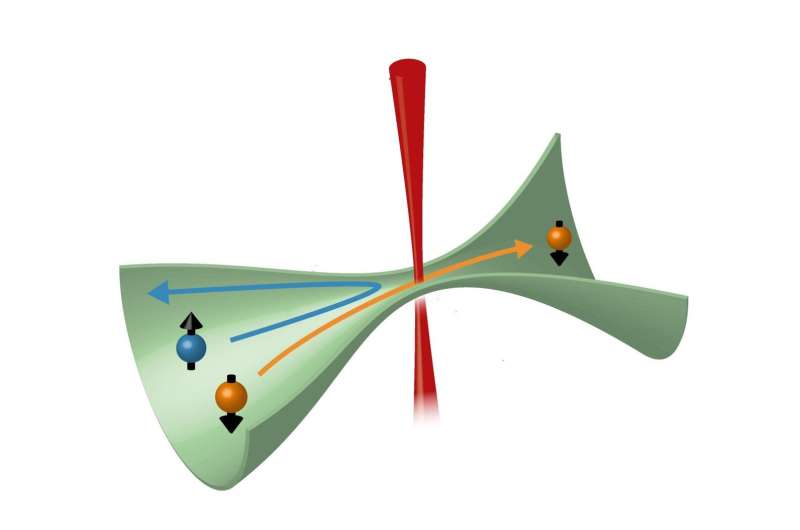A distinct spin on atomic transport

One of the more unexpected things that can be done with charge-neutral atoms is using them to emulate the fundamental behavior of electrons. Over the past few years, the group of Tilman Esslinger at the Institute of Quantum Electronics in the Department of Physics of ETH Zurich has pioneered a platform in which atoms cooled to temperatures close to absolute zero are transported through one- and two-dimensional structures, driven by a potential difference. In this way, defining phenomena occuring in mesoscopic electronic systems can be studied in great detail, including quantized conductance. In a pair of papers published today in Physical Review Letters and Physical Review A, postdoc Laura Corman, former Ph.D. student Martin Lebrat and colleagues in the Esslinger group report that they have mastered in their transport experiments control over quantum spin.
The team added a tightly focused light beam to the transport channel that induces local interactions equivalent to exposing the atoms to a strong magnetic field. As a consequence, the degeneracy of the spin states is lifted, which in turn serves as the basis for an efficient spin filter: Atoms of one spin orientation are repelled, whereas those of another orientation are free to pass (see the figure). Importantly, even though the application of an additional light field leads to the loss of atoms, these dissipative processes do not destroy the quantization of conductance. The ETH researchers replicate this experimental finding in numerical simulation and substantiate its validity through an extension of the Landauer-Büttiker model, the key formalism for quantum transport.
The efficiency of the atomic spin filter demonstrated by the Esslinger group matches that of the best equivalent elements for electronic systems. This, together with the extraordinary cleanness and controllability of the cold-atom platform, opens up exciting new perspectives for exploring the dynamics of quantum transport. In particular, as the interaction between the atoms can be tuned, the platform provides access to spin transport of strongly correlated quantum systems. This regime is difficult to study otherwise, but is of considerable fundamental and practical interest, not least for applications in spintronic devices and to explore fundamental phases of matter.
More information: Martin Lebrat et al, Quantized Conductance through a Spin-Selective Atomic Point Contact, Physical Review Letters (2019). DOI: 10.1103/PhysRevLett.123.193605
Laura Corman et al. Quantized conductance through a dissipative atomic point contact, Physical Review A (2019). DOI: 10.1103/PhysRevA.100.053605
Journal information: Physical Review Letters , Physical Review A
Provided by ETH Zurich





















